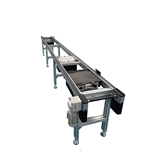Conveyor systems play a crucial role in various industries, streamlining the movement of goods and materials. However, ensuring their efficient operation and minimizing costs can be a challenge. In this guide, we will delve into the realm of conveyor systems, sharing valuable insights and practical tips to help you optimize performance while saving money. From maintenance techniques to energy-saving methods and automation solutions, we will cover it all. So, let's dive in and explore the world of efficient operation and cost-saving tips for conveyor systems.
1. Regular Maintenance and Inspections
To keep your conveyor system running smoothly, establish a routine maintenance schedule. Regularly inspect belts, rollers, motors, and other components for wear and tear. Address any issues promptly to prevent costly breakdowns. Lubricate moving parts as recommended by the manufacturer to reduce friction and extend their lifespan.
2. Optimize Conveyor Speed
Fine-tuning the speed of your conveyor system can have a significant impact on efficiency and energy consumption. Find the optimal speed that ensures smooth product flow while avoiding unnecessary strain on the system. By avoiding excessive speeds, you can reduce wear and tear on components and extend their lifespan.
3. Energy-Efficient Motors
Consider upgrading to energy-efficient motors for your conveyor system. These motors consume less power while delivering the same level of performance. By reducing energy consumption, you can lower your operational costs and contribute to a greener environment.
4. Conveyor Belt Selection
The choice of conveyor belt can greatly impact efficiency and maintenance costs. Opt for high-quality belts that are durable, resistant to wear, and require minimal maintenance. Conduct thorough research to identify the most suitable belt for your specific application.
5. Automation and Sensor Technology
Implementing automation and sensor technology can significantly enhance the efficiency of your conveyor system. Utilize sensors to detect product flow, optimize speed, and minimize waste. Automated sorting systems can streamline operations and reduce labor costs, making your system more efficient and cost-effective.
6. Proper Loading Techniques
Properly loading products onto the conveyor system is crucial for smooth operation. Train employees on effective loading techniques to minimize jams and ensure optimal utilization of the conveyor's capacity. This can reduce downtime and improve overall system efficiency.
Reduce Energy Costs with Your Conveyor System
Energy costs can be a significant expense for businesses operating conveyor systems. However, with the right strategies, you can minimize energy consumption and achieve substantial cost savings. In this guide, we will explore various techniques and technologies that can help you reduce energy costs associated with your conveyor system. By implementing these measures, you can enhance energy efficiency, lower operational expenses, and contribute to a greener environment. Let's dive in and discover how to reduce energy costs with your conveyor system.
Reducing Energy Costs with Your Conveyor System
Implementing energy-saving measures within your conveyor system can lead to substantial cost reductions. Consider the following strategies to optimize energy efficiency and minimize expenses:
1. Variable Frequency Drives (VFDs)
Install variable frequency drives to control the speed of conveyor motors based on the required load. VFDs allow for precise adjustments, ensuring that motors only consume the necessary energy for each task. By reducing motor speed during periods of lower demand, you can achieve significant energy savings.
2. Energy-Efficient Motors
Upgrade to energy-efficient motors designed specifically for conveyor systems. These motors are designed to minimize energy consumption while maintaining high performance levels. By replacing outdated or inefficient motors, you can lower energy costs and improve overall system efficiency.
3. Smart Control Systems
Invest in intelligent control systems that optimize the operation of your conveyor system. These systems use sensors and advanced algorithms to monitor and adjust motor speed, product flow, and energy usage. By integrating smart controls, you can fine-tune system performance, reduce energy waste, and achieve substantial cost savings.
4. Efficient Lighting
Consider upgrading the lighting system around your conveyor system to energy-efficient alternatives. Replace traditional fluorescent lights with LED fixtures, which consume significantly less energy and have a longer lifespan. Proper lighting can improve visibility, reduce accidents, and further contribute to overall energy savings.
5. System Monitoring and Analytics
Implement a comprehensive monitoring and analytics system to gain insights into energy consumption patterns and identify areas for improvement. By monitoring power usage, motor performance, and other relevant metrics, you can pinpoint inefficiencies and take proactive measures to optimize energy usage and reduce costs.
6. Proper System Sizing
Ensure that your conveyor system is properly sized to match the specific requirements of your operations. An oversized system can result in unnecessary energy consumption, while an undersized system may lead to bottlenecks and decreased efficiency. Consult with experts to accurately determine the ideal system size for your needs.
Tips for Maximizing Load Capacity in Your Conveyor System
Maximizing the load capacity of your conveyor system is crucial for achieving efficiency and productivity in material handling operations. By utilizing effective strategies, you can ensure that your system operates at its full potential, accommodating higher volumes and heavier loads. In this guide, we will share valuable tips to help you maximize the load capacity of your conveyor system. From selecting the right belts to optimizing conveyor speed and implementing load distribution techniques, these strategies will enhance efficiency and productivity. Let's explore the tips for maximizing load capacity in your conveyor system.
1. Proper Belt Selection
Selecting the appropriate belt is crucial for maximizing load capacity. Choose belts that are specifically designed to handle the intended load and material type. Consider factors such as belt width, strength, and flexibility to ensure optimal performance. Consulting with experts or referring to manufacturer guidelines can help you make the right belt selection for your application.
2. Optimized Conveyor Speed
Fine-tune the speed of your conveyor system to optimize load capacity. Adjust the speed based on the load requirements, ensuring that it is neither too fast nor too slow. Running the conveyor at the right speed minimizes product spillage, reduces strain on the system, and improves overall efficiency.
3. Load Distribution Techniques
Implement load distribution techniques to evenly distribute the weight across the conveyor system. Uneven loading can lead to imbalances, increased wear and tear, and decreased load capacity. Utilize techniques such as load dividers, chutes, and guides to distribute the weight evenly, ensuring smooth operation and maximizing load capacity.
4. Conveyor Support Structure
Ensure that the conveyor support structure is sturdy and properly designed to handle the intended load capacity. Weak or inadequate support structures can lead to system instability and reduced load capacity. Consult with structural engineers or conveyor system experts to assess and reinforce the support structure, if necessary.
5. Regular Maintenance and Inspection
Regularly maintain and inspect your conveyor system to identify and address any issues that may affect load capacity. Conduct routine inspections of belts, rollers, bearings, and other components for wear, damage, or misalignment. Promptly address any maintenance needs to prevent downtime and ensure optimal load capacity.
6. Employee Training and Load Handling Techniques
Train employees on proper load handling techniques to minimize the risk of damage and maximize load capacity. Educate them on weight distribution, secure packaging methods, and proper loading procedures. Well-trained employees can handle loads efficiently, reducing the likelihood of overloading or imbalanced loads.
In conclusion, optimizing the performance and minimizing costs of conveyor systems is essential for various industries. By implementing regular maintenance and inspections, optimizing conveyor speed, utilizing energy-efficient motors, selecting the right conveyor belt, incorporating automation and sensor technology, and practicing proper loading techniques, businesses can achieve efficient operation and cost savings. Moreover, reducing energy costs with the use of variable frequency drives, energy-efficient motors, smart control systems, efficient lighting, system monitoring and analytics, and proper system sizing can lead to significant financial savings and environmental benefits. Additionally, maximizing the load capacity of conveyor systems through proper belt selection, optimized conveyor speed, load distribution techniques, sturdy support structures, regular maintenance and inspections, and employee training can enhance efficiency and productivity in material handling operations. By implementing these strategies, businesses can ensure the smooth operation of their conveyor systems while achieving cost savings and improving overall performance.


-160x160-state_article-rel-cat.png)


















